Corn that has been genetically modified to produce ninja-like molecules can assault invading fungi, halting the creation of carcinogenic poisons.
These specific RNA molecules sit and wait for Aspergillus, a fungal that can contaminate grains and beans. The chemicals then pounce, preventing the mold from manufacturing a crucial protein responsible for aflatoxins, according to a study published March 10 in Science Advances. With aflatoxins and other fungal toxins damaging up to 25% of crops worldwide, the researchers believe their discovery could help improve global food safety.
“If there is no protein, there is no toxin,” explains Monica Schmidt, a plant geneticist at the University of Arizona in Tucson.
Aflatoxin is a toxin produced naturally by the fungus Aspergillus flavus. A gray-green or yellow-green mold growing on maize kernels in the field or in storage can identify the fungus. Aflatoxin levels are typically elevated during fungal growth due to plant stress caused by drought, heat, or insect attack. Aflatoxin contamination will diminish the value of the feed and impede sales. Because it is particularly toxic to warm-blooded animals even at low concentrations, grain processing facilities frequently test for the presence of the toxin before purchasing maize.
Aflatoxin levels are typically elevated during fungal growth due to plant stress caused by drought, heat, or insect attack. Long-term exposure to lower levels of these aflatoxins may stunt child development and cause liver cancer. It’s not just an economic issue, it’s a health issue.
Monica Schmidt
Schmidt and colleagues utilized RNA interference, a technique that takes advantage of a natural defense mechanism that organisms use to protect themselves from viruses. The researchers engineered corn to produce small fragments of RNA that correspond to regions of RNA produced by the fungus from the aflC gene. That gene encodes a critical step in a metabolic process used by the fungus to produce toxins. When the changed RNAs in corn match those of the fungus, Aspergillus begins to chop up its own RNA, blocking the production of a crucial protein and consequently the toxin.
The researchers next infected both designed and unmodified corn with A. flavus, an Aspergillus species known for producing the most toxic aflatoxins. The researchers were unable to identify aflatoxins in the modified corn after allowing it to grow for a month. Schmidt claims that they consistently found more than 1,000 parts per billion of aflatoxin in the unaltered corn, and sometimes as high as 200,000 ppb. Crops intended for human consumption are used for animal feed or destroyed in the United States if they contain more than 20 ppb. Each year, contaminated foods that are unsafe for humans or animals cost $270 million.

In countries that don’t screen for toxins, people eat the infected corn. That can cause vomiting, abdominal pain and even induce coma at higher levels. Long-term exposure to lower levels of these aflatoxins may stunt child development and cause liver cancer.
“It’s not just an economic issue, it’s a health issue,” Schmidt says.
Allowing A. flavus to flourish and focusing on stopping it from producing the toxin is a sensible method, according to Charles Woloshuk, a plant pathologist at Purdue University in West Lafayette, Indiana. Attempts to create fungus-resistant crops to fight aflatoxins have previously failed. However, targeting the fungus in this manner may result in fungal changes that allow it to continue infecting crops, according to Woloshuk.
RNA interference is not without risk. The carefully created RNA may go rogue and alter kernel development or plant growth in ways it was not intended to. However, an examination of the genetically altered corn revealed that the RNA is following the script.
“That’s a good piece of data,” Woloshuk says.
Other current infection control approaches focus on keeping Aspergillus at bay by storing harvested maize in an airtight container. But it won’t work if the corn is infected before it’s picked. Schmidt believes that combining genetically engineered maize, which protects the crop as it grows in the field, with post-harvest storage practices would be the best way to prevent Aspergillus contamination of the corn.
“This is the first step in demonstrating viability, but the actual goal is to get it onto customer plates,” she adds. “I realize that’s a long way down the road, but I’m hoping someone wants to push it.”
Management practices such as thorough grain cleaning, proper combine adjustment to reduce kernel damage, matching drying capacity to wet corn holding capacity, proper drying, removal of fines and broken kernels, proper grain cooling after drying, and sound storage practices help to reduce aflatoxin contamination problems.
















